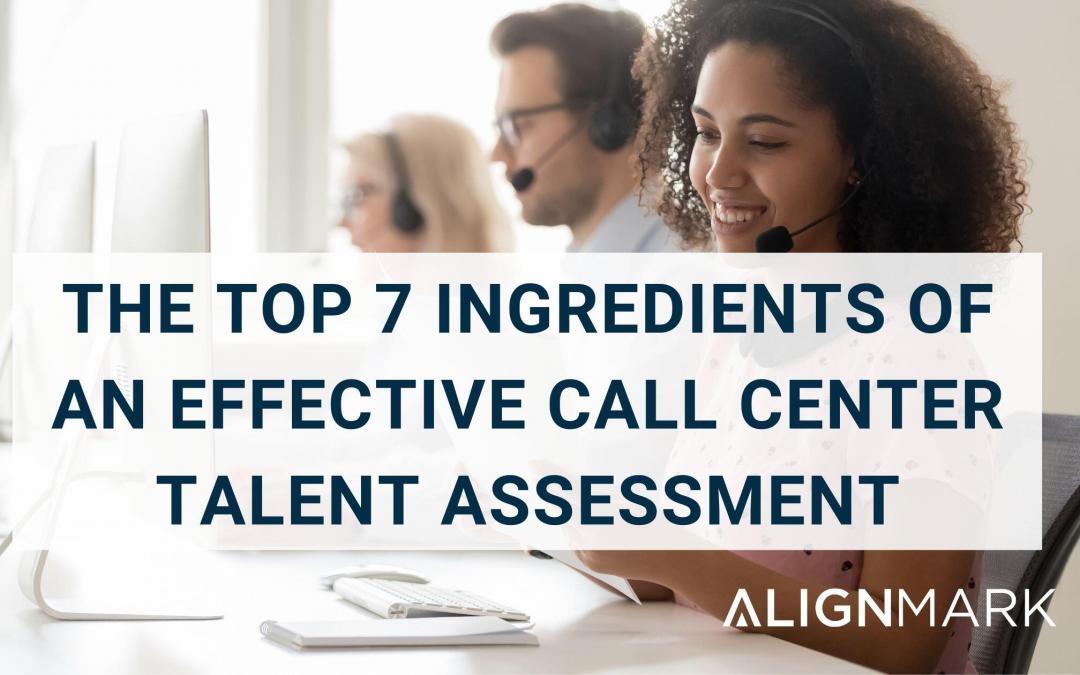Table of Contents
The importance of call center assessments in finding and retaining top talent
All call centers have a need to hire and retain the best talent for dealing with their customers. Therefore, it is very important to ensure that you do everything possible to get the right talent into those front-line positions.
An effective Call Center Assessment can be a great tool to help solve many call center hiring challenges. Most call centers (or contact centers as some like to refer to them) struggle to hire customer service representatives (CSR’s) who can perform on the job as well as stay with the company for long periods of time. With the average agent attrition rate at 30% or higher, according to contact babel it is easy to understand the importance of hiring the right agents from the start in order to stay on the lower range of this turnover issue. Assessments, when done correctly can have a significant impact on a company’s turnover which ultimately impacts the bottom line.
What is a call center assessment?
A call center assessment or test, measures skills and abilities of a job applicant that are intricate to being successful in a call center representative position. As identified through numerous job analysis studies, some of the key skills that should be measured include: customer relations ability, sales ability, data entry, math, and others. A feedback report that results from the assessment then provides hiring managers with details on the overall probability of success, a skill breakdown showing strengths and weaknesses, and additional data points that all lead to better hiring decisions.
There are numerous forms and types of assessments, each of which has a place in any hiring process. Success on any job is often made up of many different factors such as skills, abilities, interest in the job, motivation, etc. And while assessments such as personality tests, intelligence tests, brief interest surveys, and even interviews can be used, there are a lot of smart, “normal” personality individuals that can talk their way through the interview that do not have the specific customer service skills to effectively perform the job.
So given the premise that an assessment is a very valuable tool to help make smarter, and better, hiring decisions there are certain key factors that should be examined.

Here are the top 7 ingredients that make up an effective call center assessment.
1. An assessment that uses video-based, job simulation methodologies.
Video-based assessment – Job simulation has been proven to be one of the most accurate means of predicting on-the-job performance. Assessments that use simulation technology allow the candidate to demonstrate how they would perform similar situations to those encountered in the assessment, if they were on the job. Simulators often use video as the stimulus to present those simulations, especially for entry-level jobs.
The use of video is a much better delivery methodology for the assessment over text-based situations. A good call center assessment job simulation will use video to illustrate the question both in video and verbally and guide the applicant through the assessment using real life situations. By using video, you get a number of benefits that text-based assessments can’t provide.
- The use of video accommodates different learning styles. For instance, if the candidate has poor reading skills and they aren’t understanding the question, video can help them overcome this and measure their knowledge rather than their inability to read well. Ultimately this provides for a more “fair” and valid assessment.
- It allows for the candidate to react to real-life situations presented in the video simulation.
- Most applicants would prefer video to text because that is what they are used to with today’s consumption of information. Candidates also can see how this type of assessment is relevant to the job versus other non-simulation based assessments (i.e., personality, IQ, etc.). For example, from the applicant’s perspective why does it matter whether I would prefer to stay at home and read books versus go to a party.
2. An assessment that has gone through a rigorous validation study giving you statistically relevant data points from which you can make good decisions.
Statistically validated assessment – The more valid an assessment is the more accurate it will be in predicting success on the job. Let’s face it, anyone can create a simple survey and call it a call center assessment. Would the results of the survey taken by job applicants be worth anything? No, they would not and furthermore, it would simply lead to more of a time waste for the hiring manager at the end of the day. These kinds of assessments can also get a company into legal trouble. Make sure that the assessment you use is validated by a third party. Check the credentials of the test publisher to ensure that they have the Industrial/Organizational Psychology background needed to create valid assessments. Trusted assessments often go through a year –long process across multiple organizations to make sure their assessments are valid. That’s the type of validation you want to look for.
3. An assessment that is in compliance with ADA and EEO requirements.
Compliance with the ADA and EEO requirements – the use of video and job simulation provide an advantage for assisting individuals with various disabilities. All information is provided via audio, via text, and acted out. This allows individuals with certain physical and/or learning disabilities to make easy accommodations when taking the assessment. This is a much fairer way to assess individuals under the ADA compared to other testing methodologies. In addition, it is a truer simulation of the requirements of the job. From an EEO perspective the use of video and scoring algorithms should be used to ensure the assessment has no disparate impact. In other words, ensure that the assessment you use has data to show that all sub-groups in the population score equal to the majority.
4. An assessment that delivers a manager’s report that is easy to understand and actionable with regard to the next step for the candidate.
Delivers a good report – Any call center assessment that delivers a report that takes a half hour to read should be reconsidered. The results should roll up to a single number that can be used in either a hurdle approach (i.e., pass/fail) or a compensatory model (i.e., combine with other data). The report needs to be easy to read and actionable so that the hiring manager is able to move the candidate to the next logical step with speed.
5. An assessment that is legally defensible.
Legally defensible – The last thing you want to do is utilize something that will get you in trouble with the courts. Assessments can be challenged in the courts based on discrimination, fairness, and any number of other reasons. Make sure you use an assessment that will hold up in court and has a good track record of such.
6. As assessment that is easy to administer.
Ease of administration – Time is money so don’t create an administrative nightmare for yourself, use a call center assessment that is easy to use, stores the results and allows you to efficiently test applicants with ease.
7. Return on Investment
Return on investment – Finally, you want an assessment that returns an ROI for your business through any number of measures such as reduced turnover, improved productivity, reduced time-to-hire, etc.
Be sure your call center assessment returns an ROI for your business. There are a number of different ways to measure ROI (i.e., reduction in turnover, length of stay, training performance, on-the-job performance improvements, etc.) so but be sure to go through the process of identifying your main challenge and use an assessment that will help you overcome that challenge, thereby saving the company money in the long run.
In conclusion, call center assessments should be a part of any call center or contact center talent acquisition and hiring operation. When used effectively they provide a great measure of predictability on how your new hires will perform before they get on the job which in turn provides a significant impact on the organization’s bottom line.
Related Blog Post – AlignMark Named Top Pre-Employment Assessment by HR Tech Outlook
More information on pre employment assessments – Pre-Employment Assessments: Everything you need to know

 Dr. Jaffee (M.A., Ph.D.) is a recognized expert in the field of assessments, and has created effective HR Solutions used by millions of people.
Dr. Jaffee (M.A., Ph.D.) is a recognized expert in the field of assessments, and has created effective HR Solutions used by millions of people.